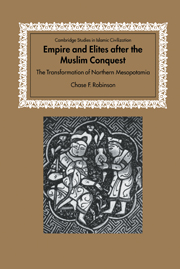Book contents
- Frontmatter
- Contents
- Preface
- Acknowledgements
- List of abbreviations
- Note on dates and citations
- Map: The Fertile Crescent in the early Abbasid period
- 1 Conquest history and its uses
- 2 The seventh-century Jazira
- 3 From garrison to city: the birth of Mosul
- 4 Christian élites in the Mosuli hinterland: the Shahārija
- 5 Islam in the north: Jaziran Khārijism
- 6 Massacre and narrative: the Abbasid Revolution in Mosul I
- 7 Massacre and élite politics: the Abbasid Revolution in Mosul II
- Conclusion
- Bibliography
- Index
- Other titles in the series
7 - Massacre and élite politics: the Abbasid Revolution in Mosul II
Published online by Cambridge University Press: 13 August 2009
- Frontmatter
- Contents
- Preface
- Acknowledgements
- List of abbreviations
- Note on dates and citations
- Map: The Fertile Crescent in the early Abbasid period
- 1 Conquest history and its uses
- 2 The seventh-century Jazira
- 3 From garrison to city: the birth of Mosul
- 4 Christian élites in the Mosuli hinterland: the Shahārija
- 5 Islam in the north: Jaziran Khārijism
- 6 Massacre and narrative: the Abbasid Revolution in Mosul I
- 7 Massacre and élite politics: the Abbasid Revolution in Mosul II
- Conclusion
- Bibliography
- Index
- Other titles in the series
Summary
From the accounts recorded by al-Balādhurī, al-Azdī, and the Chronicle of 1234, we can piece together a detailed picture of the events of the massacre; in al-Balādhurī and al-Azdī we also have evidence for the reconstructions that prevailed in the city during the ninth century; and in al-Azdī's we can also see in some detail how one tenth-century historian argued his case. This said, we are hard put to discern ayn convincing causes for the massacer, much less the larger political context into which the dreadful events are to be placed. In large part this is because the Taʿrīkh is of a piece with other examples of Abbasid historiography, in which revolutionary accounts so frequently propose a deceptively narrow range of action: politics is figured as a zero–sum game, where hostility to the Abbasids meant sympathy for the Umayyads, and taswīd forced tabyīḍ: things are quite literally black and white. But Aḥmad b. ʿAbd Allāh al-Saʿd’'s wild assertion that the city folk were Umayyad is precisely that: Umayyad sympathy cannot be squared with the evidence. Nor can one hold with Forand that the massacre ‘must have stemmed from serious opposition to the ʿAbbāsid revolution’. The Mosulis were not counter-revolutionaries, and if the ferocious violence of 133 is typical enough of revolutionary periods,the massacre can be compared neither to the Terror nor to mere chouannaries.
- Type
- Chapter
- Information
- Empire and Elites after the Muslim ConquestThe Transformation of Northern Mesopotamia, pp. 147 - 164Publisher: Cambridge University PressPrint publication year: 2000



